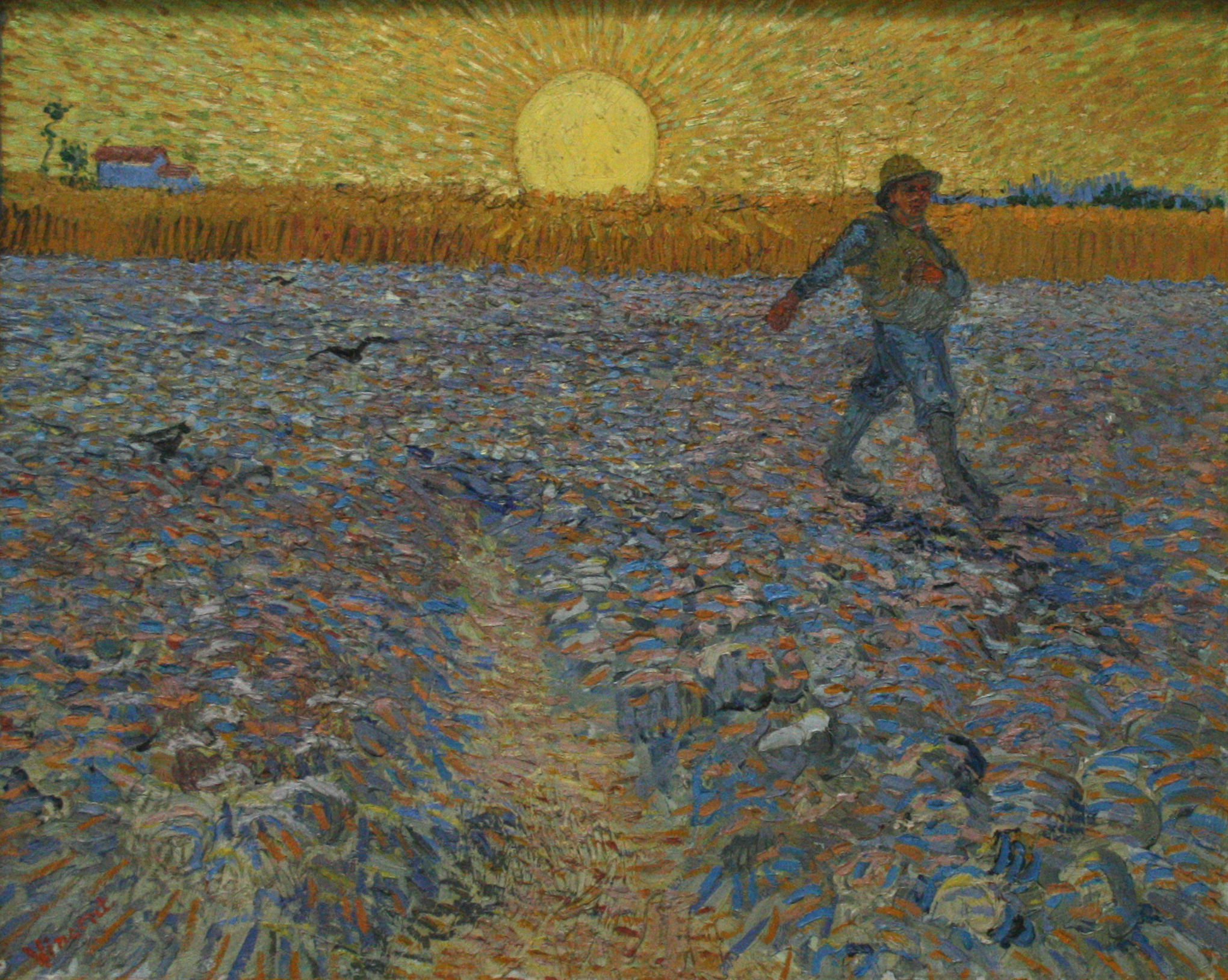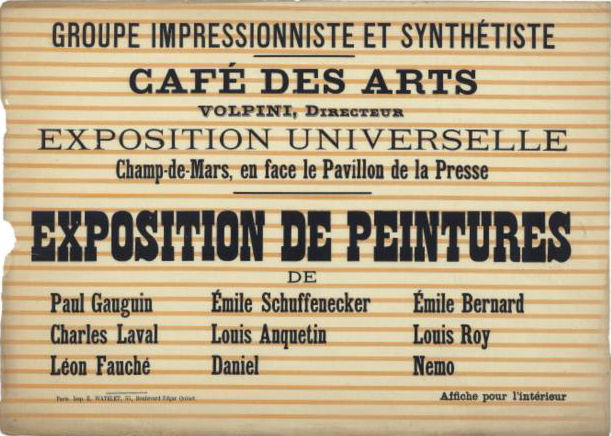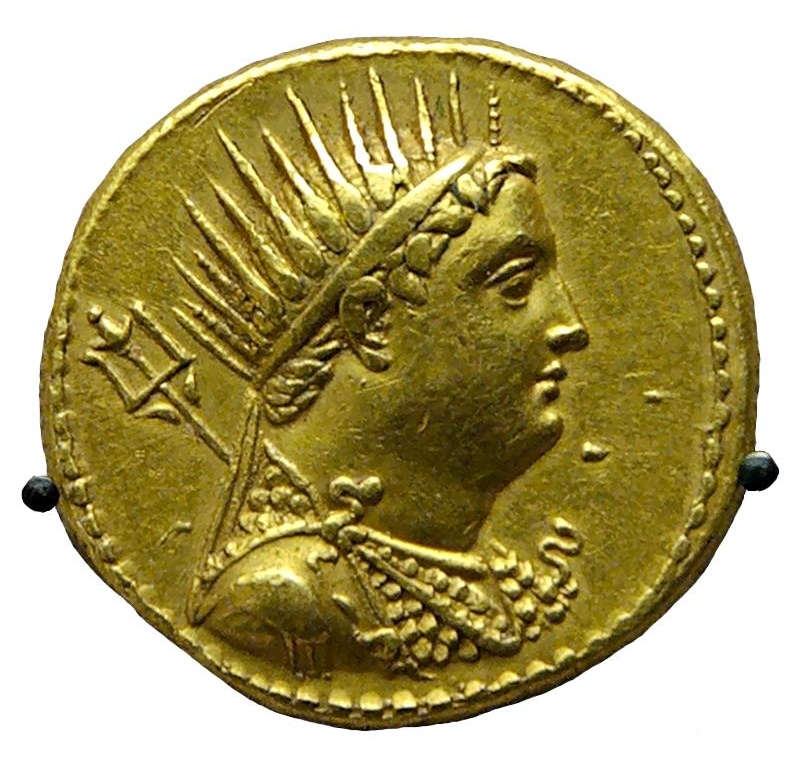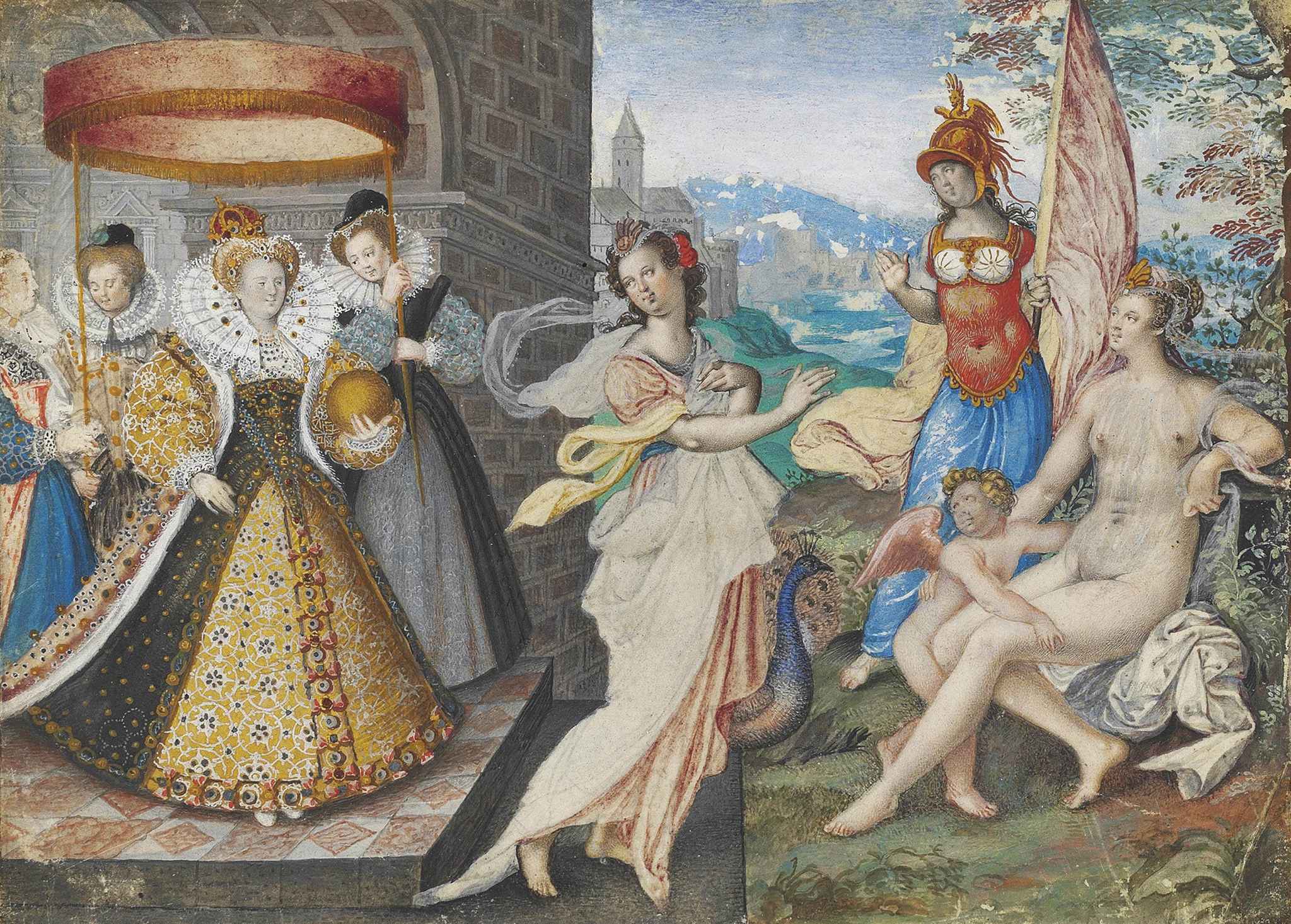|
Wheat Fields (Van Gogh Series)
''Wheat Fields'' is a series of dozens of paintings by Dutch Post-Impressionist artist Vincent van Gogh, products of his religious studies and sermons, connection to nature, appreciation of manual laborers and desire to provide a means of offering comfort to others. The wheat field works demonstrate his progression as an artist from ''Wheat Sheaves'' made in 1885 in the Netherlands to the colorful and dramatic 1888–1890 paintings from Arles, Saint-Rémy-de-Provence, Saint-Rémy and Auvers-sur-Oise in rural France. Wheat as a subject Failing to find a vocation in ministry, Van Gogh turned to art as a means to express and communicate his deepest sense of the meaning of life. Cliff Edwards, author of ''Van Gogh and God: A Creative Spiritual Quest'' wrote: "Vincent's life was a quest for unification, a search for how to integrate the ideas of religion, art, literature, and nature that motivated him." Van Gogh came to view painting as a calling, "I feel a certain indebtednes ... [...More Info...] [...Related Items...] OR: [Wikipedia] [Google] [Baidu] |
Post-Impressionist
Post-Impressionism (also spelled Postimpressionism) was a predominantly French art movement that developed roughly between 1886 and 1905, from the last Impressionist exhibition to the birth of Fauvism. Post-Impressionism emerged as a reaction against Impressionists' concern for the naturalistic depiction of light and colour. Its broad emphasis on abstract qualities or symbolic content means Post-Impressionism encompasses Les Nabis, Neo-Impressionism, Symbolism, Cloisonnism, the Pont-Aven School, and Synthetism, along with some later Impressionists' work. The movement's principal artists were Paul Cézanne (known as the father of Post-Impressionism), Paul Gauguin, Vincent van Gogh and Georges Seurat. The term Post-Impressionism was first used by art critic Roger Fry in 1906.Peter Morrin, Judith Zilczer, William C. Agee, ''The Advent of Modernism. Post-Impressionism and North American Art, 1900-1918'', High Museum of Art, 1986 Critic Frank Rutter in a review of the Salon ... [...More Info...] [...Related Items...] OR: [Wikipedia] [Google] [Baidu] |
Borinage
The Borinage () is an area in the Walloon province of Hainaut in Belgium. The name derives from the coal mines of the region, ''bores'', meaning mineshafts. In French, the inhabitants of the Borinage are called Borains. The provincial capital, Mons, is located in the east of the Borinage, but there was a great sociological difference between the inhabitants of Mons and the Borains of the villages around Mons. Rise and fall of coal "From the 18th century to 1850, the economy of thirty municipalities in the Borinage was founded on coal mining. Between 1822 and 1829, production more than doubled in that region i.e. from 602,000 to 1,260,000 tons. That was more than the total production of France and Germany at the time. The Borinage exported its coal mostly to France and Flanders." In 1878, several fossils of iguanodons were found: this find was unique because complete skeletons were present. When this area was occupied by the Germans in World War I, a few attempts were made ... [...More Info...] [...Related Items...] OR: [Wikipedia] [Google] [Baidu] |
Harrow (tool)
In agriculture, a harrow is a farm implement used for surface tillage. It is used after ploughing for breaking up and smoothing out the surface of the soil. The purpose of harrowing is to break up clods and to provide a soil structure, called tilth, that is suitable for planting seeds. Coarser harrowing may also be used to remove weeds and to cover seed after sowing. Harrows differ from ploughs, which cut the upper 12 to 25 centimetre (5 to 10 in) layer of soil, and leave furrows, parallel trenches. Harrows differ from cultivators in that they disturb the whole surface of the soil, while a cultivator instead disturbs only narrow tracks between the crop rows to kill weeds. There are four general types of harrows: disc harrows, tine harrows (including spring-tooth harrows, drag harrows, and spike harrows), chain harrows, and chain-disk harrows. Harrows were originally drawn by draft animals, such as horses, mules, or oxen, or in some times and places by manual labourer ... [...More Info...] [...Related Items...] OR: [Wikipedia] [Google] [Baidu] |
Theo Van Gogh (art Dealer)
Theodorus van Gogh (; 1 May 1857 – 25 January 1891) was a Dutch art dealer and the younger brother of Vincent van Gogh. His support of his older brother's artistic ambitions and well-being allowed Vincent to devote himself entirely to painting. As an art dealer, Van Gogh played a crucial role in introducing contemporary French art to the public. Van Gogh died at the age of 33, six months after Death of Vincent van Gogh, his brother's death at age 37. Van Gogh owned almost all of his brother's artwork. His widow, Johanna van Gogh-Bonger, worked to promote the work of Vincent and keep the memory of her husband alive. In 1914, Van Gogh's remains were buried next to those of his brother Vincent. Early life Theodorus van GoghNaifeh, Steven and Gregory White Smith. Van Gogh: the Life, p.23 New York: Random House (2011); was born on 1 May 1857 in the village of Zundert, Groot-Zundert in the province of North Brabant, Netherlands. He was the son of Theodorus van Gogh and Anna ... [...More Info...] [...Related Items...] OR: [Wikipedia] [Google] [Baidu] |
Jules Breton
Jules Adolphe Aimé Louis Breton (; 1 May 1827 – 5 July 1906) was a 19th-century French Naturalism (arts), naturalist Painting, painter. His paintings are heavily influenced by the French countryside and his absorption of traditional methods of painting helped make him one of the primary transmitters of the beauty and idyllic vision of rural existence. Early life and training Breton was born on 1 May 1827 in Courrières, a small Pas-de-Calais village. His father, Marie-Louis Breton, supervised land for a wealthy landowner. His mother died when Jules was four and he was brought up by his father. Other family members who lived in the same house were his maternal grandmother, his younger brother, Émile Breton, Émile, and his uncle Boniface Breton. A respect for tradition, a love of the land and for his native region remained central to his art throughout his life and provided the artist with many scenes for his Salon compositions. His first artistic training was not far f ... [...More Info...] [...Related Items...] OR: [Wikipedia] [Google] [Baidu] |
Jean-François Millet
Jean-François Millet (; 4 October 1814 – 20 January 1875) was a French artist and one of the founders of the Barbizon school in rural France. Millet is noted for his paintings of peasant farmers and can be categorized as part of the Realism art movement. Toward the end of his career, he became increasingly interested in painting pure landscapes. He is known best for his oil paintings but is also noted for his pastels, Conté crayon drawings, and etchings. Life and work Youth Millet was the first child of Jean-Louis-Nicolas and Aimée-Henriette-Adélaïde Henry Millet, members of the farming community in the village of Gruchy, in Gréville-Hague, Normandy, close to the coast.Murphy, p.xix. Under the guidance of two village priests—one of them was vicar Jean Lebrisseux—Millet acquired a knowledge of Latin and modern authors. But soon he had to help his father with the farm work, because Millet was the eldest of the sons. So all the farmer's work was familiar to him: to ... [...More Info...] [...Related Items...] OR: [Wikipedia] [Google] [Baidu] |
Vincent Van Gogh - Peasant Woman Binding Sheaves (after Millet) - Google Art Project
Vincent (Latin: ''Vincentius'') is a masculine given name originating from the Roman name ''Vincentius'', which itself comes from the Latin verb ''vincere'', meaning "to conquer." People with the given name Artists *Vincent Apap (1909–2003), Maltese sculptor *Vincent van Gogh (1853–1890), Dutch Post-Impressionist painter *Vincent Munier (born 1976), French wildlife photographer Saints *Vincent of Saragossa (died 304), deacon and martyr, patron saint of Lisbon and Valencia *Vincent, Orontius, and Victor (died 305), martyrs who evangelized in the Pyrenees *Vincent of Digne (died 379), French bishop of Digne *Vincent of Lérins (died 445), Church father, Gallic author of early Christian writings *Vincent Madelgarius (died 677), Benedictine monk who established two monasteries in France *Vincent Ferrer (1350–1419), Valencian Dominican missionary and logician *Vincent de Paul (1581–1660), Catholic priest who served the poor *Vicente Liem de la Paz (Vincent Liem the Nguyen ... [...More Info...] [...Related Items...] OR: [Wikipedia] [Google] [Baidu] |
Eugène Delacroix
Ferdinand Victor Eugène Delacroix ( ; ; 26 April 1798 – 13 August 1863) was a French people, French Romanticism, Romantic artist who was regarded as the leader of the French Romantic school.Noon, Patrick, et al., ''Crossing the Channel: British and French Painting in the Age of Romanticism'', p. 58, Tate Publishing, 2003. In contrast to the Neoclassicism, Neoclassical perfectionism of his chief rival Ingres, Delacroix took for his inspiration the art of Rubens and painters of the Venetian Renaissance, with an attendant emphasis on colour and movement rather than clarity of outline and carefully modelled form. Dramatic and romantic content characterized the central themes of his maturity, and led him not to the classical models of Greek and Roman art, but to travel in North Africa, in search of the exotic. Friend and spiritual heir to Théodore Géricault, Delacroix was also inspired by Lord Byron, with whom he shared a strong identification with the "forces of the Sublim ... [...More Info...] [...Related Items...] OR: [Wikipedia] [Google] [Baidu] |
Halo (religious Iconography)
A halo (), also called a nimbus, aureola, aureole, glory or gloriole (), is a crown of light rays, circle or disk of light that surrounds a person in works of art. The halo occurs in the iconography of many religions to indicate holy or sacred figures, and has at various periods also been used in images of rulers and heroes. In the religious art of Ancient Greece, Ancient Rome, Christianity, Hinduism, and Buddhism (among other religions), sacred persons may be depicted with a halo in the form of a circular glow, or flames in Asian art, around the head or around the whole body—this last form is often called a mandorla. Halos may be shown as almost any colour or combination of colours, but are most often depicted as golden, yellow or white (when representing light) or as red (when representing flames). The earliest artistic depictions of halos were probably in Ancient Egyptian art. Ancient Mesopotamia and Persia Sumerian religious literature frequently speaks of ( in Akkad ... [...More Info...] [...Related Items...] OR: [Wikipedia] [Google] [Baidu] |
Divinity
Divinity (from Latin ) refers to the quality, presence, or nature of that which is divine—a term that, before the rise of monotheism, evoked a broad and dynamic field of sacred power. In the ancient world, divinity was not limited to a single deity or abstract ideal but was recognized in multiple forms: as a radiant attribute possessed by gods, as a vital force pervading nature, and even as a quality glimpsed in extraordinary humans, laws, or acts. The Latin and its Greek counterparts (, ) conveyed something both immanent and awe-inspiring: a presence that could be felt in thunder, justice, ecstasy, fate, or beauty. Among the Greeks and Romans, divinity was not confined to a rigid theological system. Gods, heroes, and even emperors might be described as partaking in divinity, just as natural forces or virtue could be seen as expressions of divine essence. Philosophers such as Plato and the Stoics used the term to refer to the soul of the cosmos or the rational order ... [...More Info...] [...Related Items...] OR: [Wikipedia] [Google] [Baidu] |
Plough
A plough or ( US) plow (both pronounced ) is a farm tool for loosening or turning the soil before sowing seed or planting. Ploughs were traditionally drawn by oxen and horses but modern ploughs are drawn by tractors. A plough may have a wooden, iron or steel frame with a blade attached to cut and loosen the soil. It has been fundamental to farming for most of history. The earliest ploughs had no wheels; such a plough was known to the Romans as an ''aratrum''. Celtic peoples first came to use wheeled ploughs in the Roman era. The prime purpose of ploughing is to turn over the uppermost soil, bringing fresh nutrients to the surface while burying weeds and crop remains to decay. Trenches cut by the plough are called furrows. In modern use, a ploughed field is normally left to dry and then harrowed before planting. Ploughing and cultivating soil evens the content of the upper layer of soil, where most plant feeder roots grow. Ploughs were initially powered by humans, but th ... [...More Info...] [...Related Items...] OR: [Wikipedia] [Google] [Baidu] |
The Sower - Painting By Van Gogh
''The'' is a grammatical article in English, denoting nouns that are already or about to be mentioned, under discussion, implied or otherwise presumed familiar to listeners, readers, or speakers. It is the definite article in English. ''The'' is the most frequently used word in the English language; studies and analyses of texts have found it to account for seven percent of all printed English-language words. It is derived from gendered articles in Old English which combined in Middle English and now has a single form used with nouns of any gender. The word can be used with both singular and plural nouns, and with a noun that starts with any letter. This is different from many other languages, which have different forms of the definite article for different genders or numbers. Pronunciation In most dialects, "the" is pronounced as (with the voiced dental fricative followed by a schwa) when followed by a consonant sound, and as (homophone of the archaic pronoun ''thee' ... [...More Info...] [...Related Items...] OR: [Wikipedia] [Google] [Baidu] |








